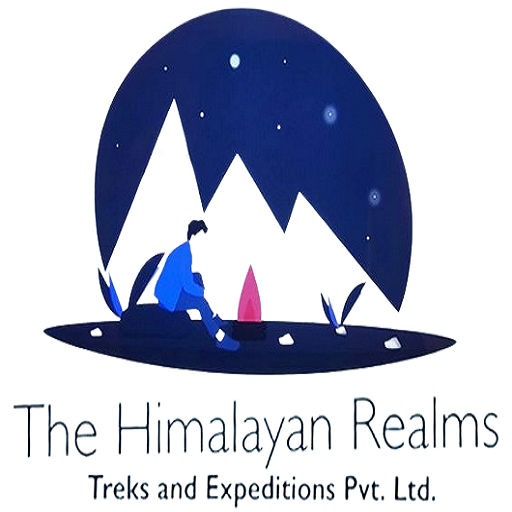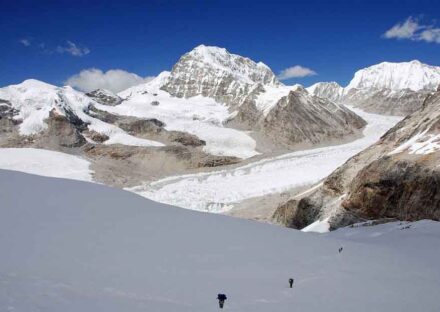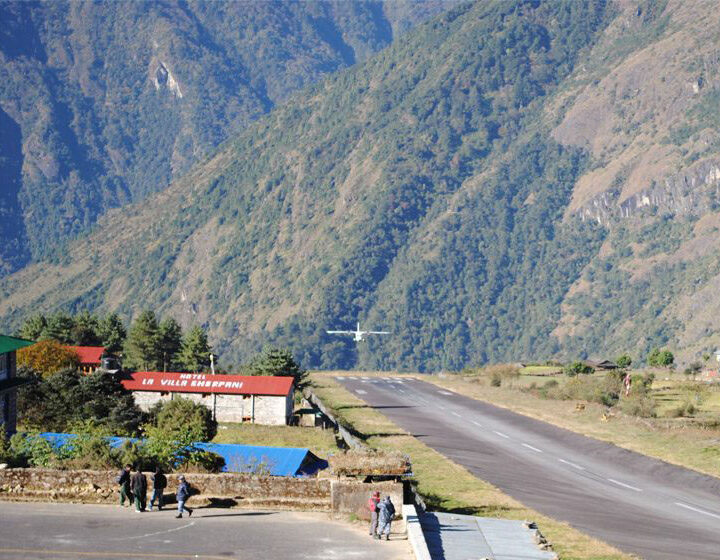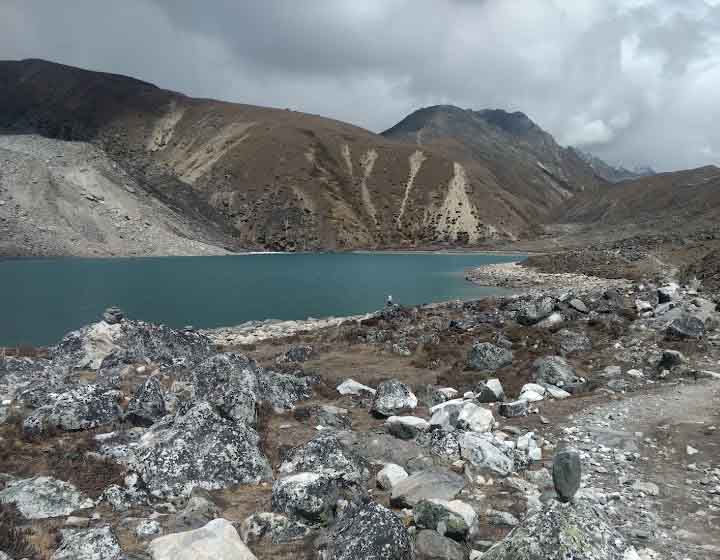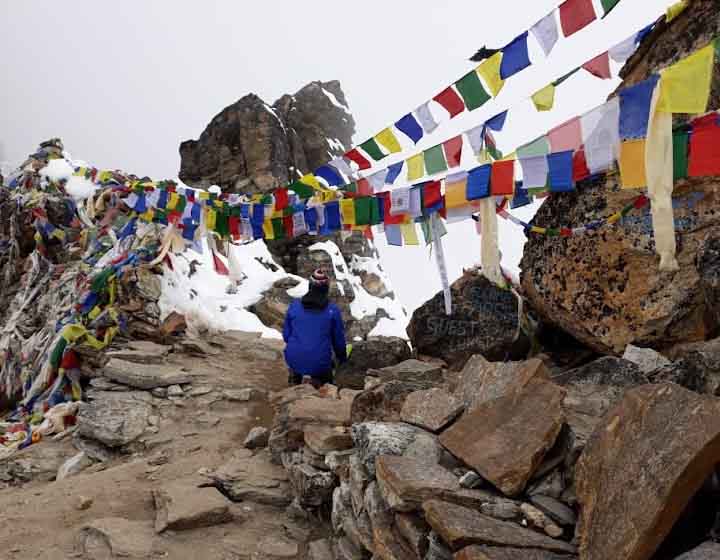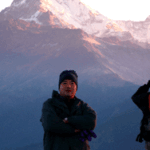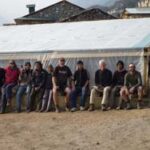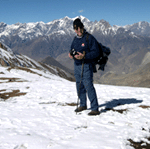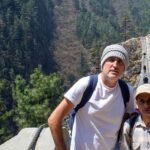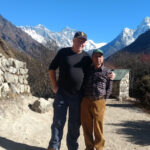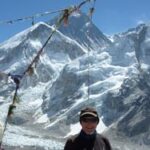Himalayan Realms Treks offers various routes in the Everest region for trekking and expeditions. Please see below for details.
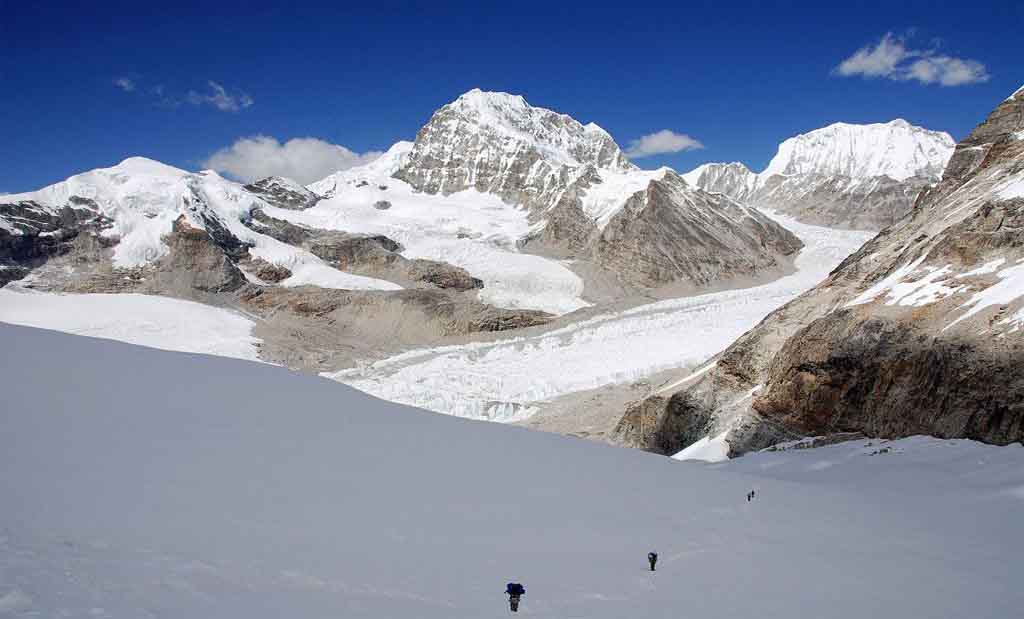
Trip Duration
19 days
Trip Grade
Moderate
Transportation
Car, Bus, flight
Max. Altitude
5,755 meters (18,881 feet)
Departure From
Kathmandlu
Destination
Nepal
Meals
Breakfast, Lunch,Dinner, tea/coffee
Accomodation
Deluxe Hotel and tea house
Season
September to December and February to May
Trip overview
Overview Tashi Lapcha pass 18-days trek
The Tashi Lapcha (Rolwaling) trek is a stunning journey with panoramic views of the Rolwaling Valley and Khumbu region. As you climb, you’ll see dramatic glaciers, towering peaks, and remote Sherpa villages. The trek offers a perfect blend of adventure and cultural exploration. Challenging terrain immerses trekkers in the traditions of Himalayan communities. It provides an unforgettable experience for those seeking thrills and beauty. The trek leads to the high-altitude Tashi Lapcha Pass (5,755 m), offering stunning Himalayan vistas. It combines the seclusion of Rolwaling with the vibrant paths of Khumbu, making it a diverse and rewarding adventure.
The Tashi Lapcha Pass (Rolwaling) trek begins with a scenic drive to Gonggar via Dolakha, passing through Simigaon, Bedding, and Na Gaon. Along the way, trekkers are treated to stunning views of Mount Gaurishankar (7,134 m). The route includes exploration of the Yalung Glacier and an acclimatization climb to Ramdung Go (5,930 m), which offers incredible alpine vistas.
The trail then ascends to Tsho Rolpa Lake (4,540 m), Nepal’s largest glacial lake. From here, the journey continues toward the icy and challenging Tashi Lapcha Pass (5,755 m), a dramatic gateway linking the remote Rolwaling Valley with the famous Khumbu region.
Once in Khumbu, trekkers are rewarded with panoramic views of Everest (8,848 m) and Cho Oyu (8,201 m). The descent passes through the traditional village of Thame and leads to Namche Bazaar, the vibrant cultural hub of the Sherpas. The trek concludes in Lukla, where a scenic flight returns you to Kathmandu—ending this unforgettable Himalayan adventure.
Vegetation and Landscape: The Lower Region (1,500 m–3,000 m) features lush rhododendron, pine, and oak woods in the lower hills. Terraced farmlands produce maize, barley, potatoes, and buckwheat.
Mid-altitude (3,000 m – 4,500 m): sub-alpine woods of juniper, fir, and birch trees.
Alpine meadows with grazing yaks. Glacial mountains are found at high altitudes ranging from 4,500 m to 5,755 m+. As you reach Tashi Lapcha Pass, you’ll see rough terrain and ice fields. The vegetation is sparse, consisting largely of mosses and lichens.
Atmosphere and Climate: Lower elevations (under 3,500 meters) are pleasant and temperate, with mild temperatures.
Mid-altitude zones (3,500m to 4,500m) become colder, particularly in the mornings and evenings.
High-altitude areas (above 4,500 meters) are frigid, with strong winds and perhaps snowfall. Extreme cold, severe winds, and unexpected weather can make the Tashi Lapcha Pass difficult to navigate.
Best Seasons for the Tashi Lapcha Trek: Spring (March-May) is the best time.
Warm temperatures, beautiful skies, and blossoming rhododendrons.
Best mountain visibility.
Best Seasons for the Tashi Lapcha Trek
Autumn (September–November): The Best Time
The weather is stable, and the trekking conditions are comfortable.
The mountain vistas are crisp and beautiful.
Main highlights:
Tashi Lapcha Pass (5,755 m/18,876 ft) is a hard and breathtaking high-altitude mountain pass in Nepal’s Rolwaling district. It connects the Rolwaling and Khumbu Valleys, offering trekkers stunning Himalayan scenery, cultural diversity, and adventure. Here’s what makes Tashi Lapcha unique:
Scenic Beauty: The Tashi Lapcha Pass trek provides breathtaking views of the Himalaya, including Mount Everest, Gaurishankar, Melungtse, and Tengi Ragi.
The trail passes through pristine glaciers, alpine meadows, and stunning rock, making it an amazing experience for nature lovers.
2. Challenging Trek: The trek is considered challenging, needing previous trekking or mountaineering experience. Climbers encounter high-altitude challenges and steep ascents. extremely technical areas, but particularly on the pass itself, which frequently necessitates the use of crampons and rope. The Tashi Lapcha expedition is perfect for adventurers seeking to push their time limit.
Cultural Experience.
The journey takes you through Sherpa, Tamang, and Gurung communities, where you may learn about local customs, hospitality, and Buddhist culture.
The Rolwaling Valley is less traveled than the Everest Base Camp; as a result, the experience feels more authentic and significantly more tranquil. Moreover, with its untouched landscapes and minimal crowds, trekkers can fully immerse themselves in nature, free from distractions. What’s more, the region’s remoteness not only heightens the sense of adventure but also deepens the connection to the Himalayas’ raw, unspoiled beauty. Consequently, this isolation fosters moments of solitude and self-discovery, making it a truly unique and rewarding journey. Ultimately, this hidden gem offers an unparalleled experience for those seeking both adventure and serenity in the heart of the Himalayas.
Rolwaling Valley:
Additionally, the Rolwaling Valley—often referred to as the “hidden valley”—is a biodiversity hotspot that has remained remarkably unspoiled, further enhancing its allure for nature lovers and adventurers alike. As you trek through this remote region, you’ll encounter charming villages, lush forests, and sacred sites, each adding a unique dimension to the journey. One of the trek’s most breathtaking highlights is Tsho Rolpa Lake, one of Nepal’s largest glacial lakes. “It not only enhances the valley’s mystical allure but also provides a serene contrast to the surrounding rugged terrain. In fact, the lake’s tranquil beauty offers a peaceful pause amid the adventure, granting trekkers a rare opportunity to reconnect with nature in its purest form.”
Beyond that, for those seeking adventure and mountaineering opportunities, the Rolwaling Valley presents a range of challenging yet rewarding experiences. As a result, it stands out as an ideal destination for outdoor enthusiasts seeking to test their limits while fully immersing themselves in nature’s untouched beauty
Starting Point: Kathmandu to Rolwaling Valley
Kathmandu to Gonggar (Drive): The trek begins with a long drive from Kathmandu to Gonggar via Charikot, passing through beautiful countryside and traditional villages. Rolwaling Valley Trek: The initial days involve trekking through lush forests, terraced fields, and Sherpa villages like Simigaon, Beding, and Na, where you acclimatize and enjoy stunning views of Gaurishankar (7,134 m). Tashi Lapcha Pass (5,755 m): The most challenging part of the trek involves high-altitude glacier trekking, requiring crampons and ropes. Proper acclimatization is crucial before crossing the pass, which connects Rolwaling to the Everest region.
Ending Point: Khumbu Region to Lukla
Descent into Thame: After crossing Tashi Lapcha, you enter the Khumbu region, where you trek through Thame, a famous Sherpa village with a historic monastery. Trek to Namche Bazaar: A relatively easy trek leads to Namche Bazaar, the vibrant gateway to Everest. <strong> Lukla and Flight to Kathmandu: The trek concludes with a descent to Lukla, where you take a scenic flight back to Kathmandu.
A True Adventure
This expedition is excellent for adventurers who want to push their limits. The rugged terrain, isolation, and breathtaking landscapes make it an unforgettable challenge.
Cultural Immersion in Remote Villages
The journey takes you through Sherpa, Tamang, and Gurung communities. You’ll experience local customs, warm hospitality, and Buddhist traditions. The Rolwaling Valley sees fewer visitors than Khumbu, making it a quieter destination. It offers a more authentic and tranquil experience. Trekkers can fully immerse themselves in nature’s untouched beauty. Travel through remote villages with preserved traditions, lush forests, and breathtaking mountain views. Each step deepens your connection to the region’s rich heritage. The serene beauty, diverse wildlife, and lush forests contrast with the rugged mountain landscapes, creating a truly unforgettable trek.
Sacred Sites and Spiritual Significance
Along the trail, you will encounter sacred sites that hold deep cultural and spiritual significance. One of the most remarkable highlights is Tsho Rolpa Lake, one of Nepal’s largest glacial lakes. Its turquoise waters reflect the towering peaks surrounding it, creating a mesmerizing view. This breathtaking destination enhances the trek’s visual appeal and fosters a tranquil atmosphere. Trekkers can fully immerse themselves in the serenity of the Himalayas. The pristine surroundings and soaring peaks showcase nature’s raw beauty, making it an ideal place for reflection and rejuvenation.
Additionally, the region holds deep spiritual significance, intricately rooted in Buddhist traditions. The trail gradually ascends to Tsho Rolpa Lake (4,540 m), offering breathtaking views along the way. From there, it continues toward the challenging and icy Tashi Lapcha Pass (5,755 m), which serves as a dramatic gateway connecting the remote Rolwaling Valley with the renowned Khumbu region. strong data-start=”62″ data-end=”77″> As a result, it adds a profound layer of depth to the journey, further enriching the overall trekking experience.
Key Attractions:
Tsho Rolpa Lake: A stunning glacial lake surrounded by towering peaks. Tashi Lapcha Pass (5,755 m): A challenging high-altitude pass that connects Rolwaling to the Everest region. It’s a highlight for adventurous trekkers seeking rugged and remote experiences.
6. Gokyo lake with Renjo-la pass trek
7. Gokyo valley with fifth lake trekking
Conclusion
The Tashi Lapcha trek is a challenging yet profound journey. It combines the wild beauty of the Rolwaling Valley with the iconic trails of the Khumbu region. Crossing the formidable Tashi Lapcha Pass (5,755 meters) is a rare achievement. This makes the trek ideal for experienced adventurers seeking solitude, dramatic alpine scenery, and true exploration. Along the route, trekkers are surrounded by the awe-inspiring peaks of Gauri Shankar and Melungtse.” “Moreover, trekkers are immersed in the rich cultural tapestry of the Sherpa and Tamang communities, which adds profound depth and meaning to their journey. In addition, for those seeking to embrace both physical challenge and spiritual growth, the Tashi Lapcha trek offers an unforgettable high-altitude adventure in the heart of the Himalayas.”
Short Itinerary
Day 1: Arrival in Kathmandu (1,400 m)
Day 2: Drive to Gongar Khola (1,400 m).
Day 3: Trek to Simigaon (2,000 m)
Day 4: Trek to Dongang (2,800 m)
Day 5: Trek to Beding (3,690 m)
Day 6: Acclimatization Day at Beding: -
Day 7: Trek to Na Village (4,180 m):
Day 8: Acclimatization Day at Na Village.
Day 9: Trek to Tsho Rolpa Lake (4,580 m):
Day 10: Trek to Trakarding Glacier (4,800 m):
Day 11: Trek to Tashilapcha High Camp (5,500 m):
Day 12: Cross Tashilapcha Pass (5,755m) and Trek to Thame (3,800m): -
Day 13: Trek to Namche Bazaar (3,440 m):
Day 14: Trek to Lukla (2,840 m):
Day 15: Trek from Namche to Lukla:
Day 16: Fly to Kathmandu from Lukla :-
Day 17: Rest day and souvenir shopping
Day 18: Departure from Kathmandu:
Itinerary
Arrival in Kathmandu:-Welcome to Nepal. Our representatives will be waiting for you at Tribhuvan International Airport, Kathmandu. They will pick you up and drop you at your hotel. Enjoy the evening strolling around the nearby market. Stay overnight at hotel in Kathmandu.
Drive from Kathmandu to Gonggar via Dolakha1660m (7/8 hours) by land cruiser and trek to Simigaon2020m (1/2 hours):-after breakfast, we drive to Gonggar via Dolakha. Along the way, we can encounter the views of Sunkoshi and Bhote Khosi rivers. Driving past Dolakha, Pikhuti, Suri Dobhan, and Manthali alongside Tama Koshi River, we arrive in Gonggar. From Gonggar, we trek past a Sherpa village through the rhododendron forest to reach Simigaon. We will have an alluring panorama of Mount Gaurishankar (7134m) from Simigaon. Stay overnight in Simigaon.
Trek from Simigaon to Daldung La 3976m (7/8 hours):-Descend downhill to a steep trail and go around the edge by climbing the vertical stone steps. Enter the rhododendron forest and walk through the trail to reach the Rolwaling River. Then, climb uphill through the forest along with the view of Mount Gaurishankar (7134m). Ascend uphill till the trail becomes flat and smooth to reach Daldung-La. Overnight at tented camp
Trek from Daldung La to Beding 3690m (7/8 hours):-The trail walks through lush rhododendron forest with ascents and descents until reaching Nyamare village. Then with a panoramic view of Mount Gaurishankar (7134m), we walk to Beding, the largest Sherpa village of Rolwaling region. There is a Gompa at the entry of the village and the holy Gaurishankar Temple a little above the village. Stay overnight at tented camp.
Exploration Day:-Today is a day set apart for acclimatization. We can either rest or go for the short excursion. We hike up to Menlung La Pass (5616m) walking on the moraines. From the top of Menlung La, a remarkable view of snowy mountains including the holy Mount Gaurishankar (7134m), glaciers, and the lush forest in the Beding valley can be seen. Stay overnight at tented camp.
Trek from Beding to Na 4180m (4/5 hours):-After breakfast, we start by a slow ascend on the bank of Rolwaling River until we reach Dhogre. After walking further, the valley slowly opens to a huge Mani stone wrapped with prayer flags and a large rock with an image of Bodhisattva painted on it. Finally, we reach Na Gaon situated on the bank of the Rolwaling River. Stay overnight at tented camp.
Acclimatization day: Hike to Ramdung Go 5930m and Yalung glacier:-We take another day for acclimatization. We walk through the icy and slippery trail of Yalung Glacier and later Ramdung Glacier to reach Ramdung Go (5930m), which is an excellent training peak for mountain climbing. An amazing view of Tsho Rolpa Lake and the surrounding glaciers, as well as mountains, can be seen from the top of Ramdung Go. We then hike back to Na Gaon for the Stay overnight at tented camp..
Trek from Na to Tsho Rolpa Lake 4540m (4/5 hours):-After breakfast, we leave Na Gaon and cross the wooden bridge over the Rolwaling River. We move on somewhat steep trail uphill. We trek on the moraines of Rolwaling Glacier to reach the majestic glacial lake. Tsho Rolpa Lake is the biggest and one of the most popular lakes in Nepal that is situated at the altitude of 4540m. The deep blue lake hosts an amazing reflection of the surrounding hills and snowy-peaks as it envelops the vicinity in tranquility. Stay overnight at tented camp.
Trek from Tsho Rolpa Lake to Trakarding Glacier 4800m (7/8 hours):-Although short, distance-wise, the trek will be tough today as we are required to walk through the icy and challenging trail of Trakarding Glacier throughout the day. With a view of several mountains like Rolwaling Kang (6664m), Takargo (6671m), and Jabou Ri (6166m) among others, we climb on a rocky terrain to reach Trakarding. Stay overnight at tented camp.
Trek from Trakarding Glacier to Tashi Labcha Phedi 5755m (6/7 hours):-The trail goes uphill through some rock climbing and a slow walk on the glacier. We now leave the trail of Trakarding Glacier and walk through Drolambau Glacier. This will be a difficult day because we walk on slippery trails. The scenic beauty will be amazing to experience as we will be seeing snow all around us. Walking on Drolambau Glacier, we arrive in Tashi Labcha Phedi. Stay overnight at camp.
Trek from Tashi Labcha Phedi to Tashi Camp 5200m (6/7 hours) via Tashi Lapcha Pass 5755m:-Steep climb from Tashi Labcha Phedi to Tashi Lapcha Pass (5755m) will lead us to Tashi Labcha Camp (5665m), which is also known as Tashi Labcha Phuk. After a hard climb, we reach the top of Tashi Labcha Pass (5755m), which separates Rolwaling region from Khumbu region. We now enter Sagarmatha National Park and descend for a short time to reach Tashi Lapcha Camp. Stay overnight at camp.
Trek from Tashi Labcha Camp to Thyangbo 4350m (4/5hours):-today, we will be experiencing relatively easier glacier walking as the trails are smooth and downhill. Descending from Tashi Labcha Camp, we arrive in Ngole, whose trail is full of snow and ice. Then we descend on the trail to reach Parchemuche Tsho, a glacial lake in the Khumbu region, en route to Thyangbo. With a view of Pasang Lhamu Chuli (7350m and Cho Oyu (8201m), we arrive in Thyangbo. Stay overnight at tented camp.
Trek from Thyangbo to Thame3820m (4/5 hours):-Early morning, we walk through yak pastureland and arrive at the yak herder’s temporary huts. This trail is bumpy and slowly goes downhill. We will follow a small stream throughout the way as we relish the beauty and calmness of the environment. We arrive at the Power House before entering the village of Thame. In the evening, we will visit the Thame Monastery and enjoy the beautiful view of the surrounding mountains. Stay overnight at tented camp
Trek from Thame to Namche Bazaar 3440m (5/6 hours):-The trail descends slowly to Samde. Get the sights of great peaks of the Khumbu including Mt Everest (8848m), Cho Oyu (8201m), Taboche (6367m), and other peaks of Khumbu region. Crossing several villages and monasteries, the trail descends to Syangboche before reaching Namche Bazaar. Then, following the trails of Bhote Koshi River, we arrive in the commercial hub of Namche Bazaar. The Sherpa town is vibrant with tourists from all around the world. Stay overnight in Namche Bazaar.
Trek from Namche to Lukla2840m (6/7 hours):-Leaving behind Namche Bazaar, we trek with Bhote Koshi River and Dudh Koshi River on our every side. Reaching the confluence of these two rivers at Larja Dobhan, we descend to Jorsalle and exit Sagarmatha National Park. Then, we trek alongside Dudh Koshi River as we cross many villages, monasteries, Mani walls, and prayer wheels to arrive in Lukla. Stay overnight at tented camp.
Fly from Lukla to Kathmandu and transfer to Hotel:-We take an early flight from Lukla to Kathmandu (40 minutes) over the spectacular mountain peaks. On arrival, you will be taken to the hotel so that you can rest and freshen up. Later, you can wander around the streets of Kathmandu and do some shopping for your loved ones back home. Feel free to get the taste of local food and lovely ambiance of Kathmandu. Stay overnight at a 3-star hotel in Kathmandu.
Rest day in Kathmandu and explore thamel area check some item and shop for souvenir gift shopping.
Departure to International Airport: Final departure day for own your destination We will drop you at Tribhuvan International Airport 3 hours before your flight time. We hope to see you again! Have a nice journey.
Included
- All airport and hotel transfers
- Kathmandu to Charikot Bus ticket for guest and staff.
- National permit, permit Gaurishanker Conservation permit
- Flight fare from Lukla-Kathmandu
- Accommodation, food, & Tea/coffee during trek
- Guide:- including salary, insurance, equipment, bus transportation, flight fare, food and lodging
- Porter:- including salary, insurance, equipment, bus transportation, food and lodging
- For guest:-Down jacket, Good sleeping bag (down jacket and sleeping bag are to be returned after trip completion)
- All government and local taxes
Not Included
- Food in Kathmandu ( Lunch & Dinner)
- Bakery food during the trek
- Nepal Visa fee
- International airfare from your country to Kathmandu and from Kathmandu
- Extra night accommodation in Kathmandu
- Travel and rescue insurance if guest get mountain sickness and need to rescue helicopter.
- Personal expenses example (phone calls, laundry service , bar bills, battery recharge, extra porters, bottle or boiled water, shower etc)
- Tips for guide and porters
Join Us Upcoming Trips
Book this trip with us. Here are the upcoming dates. Feel free to share this trip with your friends and family. For custom trips or general inquiries contact us.
| Departure Date | Trip Duration | Price | Status | |
|---|---|---|---|---|
| 22 September, 0025 | 19 days | $3615 | Fixed departure | |
| 20 September, 2025 | 19 days | $3615 | Fixed departure | |
| 12 October, 0025 | 19 days | $3615 | Fixed departure | |
| 29 October, 2025 | 19 days | $3615 | Fixed departure | |
| 15 November, 2025 | 19 days | $3615 | Fixed departure |
Useful Info
Tashi Lapcha Pass: A challenging high-altitude pass requiring technical gear and experience.
Gaurishankar Conservation Area: Rich biodiversity, including rhododendron forests and unique wildlife.
Rolwaling Valley: Remote and culturally rich, less crowded compared to other trekking routes.
Trakarding Glacier: A stunning but demanding section of the trek.
Connection to Namche Bazaar: Gateway to the Everest Region.
Trek Details
Duration: Typically 18–22 days.
Difficulty: Very challenging; requires trekking and mountaineering experience.
Max Elevation: 5,755 meters at Tashi Lapcha Pass.
Accommodation: A mix of teahouses and camping (teahouses may be sparse in remote sections).
Best Seasons:
Spring (March–May): Clear weather and blooming rhododendrons.
Autumn (September–November): stable weather and excellent visibility.
Essential Permits
Gaurishankar Conservation Area Permit (GCAP): Required for the Rolwaling section.
Sagarmatha National Park Permit: needed when entering the Everest region.
TIMS (Trekkers' Information Management System) Card: mandatory for all trekkers in Nepal.
Physical Preparation
It requires excellent fitness and acclimatization. Experience in high-altitude trekking and technical mountaineering is recommended. Familiarity with using crampons, ropes, and ice axes is essential.
Gear Checklist
Clothing: thermal layers, down jacket, waterproof shell, gloves, and warm socks.
Footwear: sturdy trekking boots and crampons.
Technical Gear: harness, rope, ice axe, and helmet (can be rented in Kathmandu).
Sleeping Gear: A -20°C sleeping bag.
Miscellaneous: sunglasses, sunscreen, first aid kit, and water purification tablets.
Challenges
Altitude sickness: gradual acclimatization is crucial.
Technical terrain: glaciers, snow, and ice crossings require skill and caution.
Remoteness: Limited infrastructure and emergency support in Rolwaling Valley.
Tips
Trek with a licensed guide or a reputable trekking company.
Carry cash as ATMs are unavailable in the Rolwaling region. Ensure you have travel insurance that covers high-altitude trekking and rescue.
Stay updated on weather forecasts and trail conditions.
FAQs
-
How difficult is the Tashi Lapcha Pass trek?
It is a challenging and technical trek that requires mountaineering skills. The crossing involves glacier travel, steep climbs, and potential rope sections. Prior high-altitude trekking or climbing experience is recommended.
-
What permits are required for the trek?
Gaurishankar Conservation Area Permit, Sagarmatha National Park Permit, Restricted Area Permit for Rolwaling Valley (obtained through a registered trekking agency)
-
Is technical climbing equipment required?
Yes, for the Tashi Lapcha Pass crossing, you need: Crampons, Ice axe, Harness, Rope (for fixed sections), Helmet, Proper insulated boots
-
What kind of accommodation is available?
Teahouses are available in lower Rolwaling and Khumbu. Camping is required in remote sections, especially around Tashi Lapcha.
-
How do you get to the starting point?
The trek starts from Gonggar or Jagat in the Rolwaling region. You can reach there via a drive from Kathmandu to Gonggar (8-10 hours).
